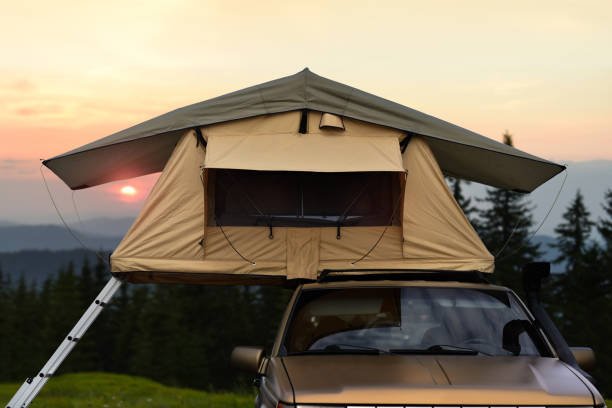Roof top tents (RTTs) have surged in popularity among overland travelers, camping enthusiasts, and van lifers in recent years. Mounted onto a vehicle roof rack, these compact hard-shell tents open to provide convenient shelter almost anywhere your adventures take you. This guide will cover everything you need to know about choosing, setting up, and enjoying rooftop tents.
What is a Roof Top Tent?
A rooftop tent is a hardshell tent designed to attach and fold out from the roof rack of a vehicle like an SUV, van, truck, or trailer. Key features include:
- The hard outer shell pops open for use and closes for storage
- Mounts onto custom or universal roof racks
- Sleeps 1-4 people, typically in camping mattresses
- Weighs 100-200 lbs
- Sets up in minutes without unpacking gear
- Provides shelter and bedding instantly anytime, anywhere
RTTs combine the joy of camping with a simplified setup. Just park and pop open for an instant home on wheels!
Benefits of Roof Top Tents
Roof top tents offer unique advantages over ground tents:
- Speed – Set up/takedown in under 5 minutes
- Convenience – No prepping site or unpacking needed
- Comfort – Elevated off-ground away from critters and moisture
- Storage – Frees interior vehicle space; gear stored intent
- Flexibility – Deploy tent anytime, anywhere vehicle can park
- Security – Off the ground and strapped onto the vehicle
- Weather Protection – Solid roof and layers buffer elements
- Consistent Sleep System – Familiar bed every night; integrates into the vehicle
RTTs allow spontaneous camping stops without the fuss of standard tenting. Just fold out and rest easy!

Types of Roof Top Tents
There are a few main classifications of RTTs:
Hard vs Soft Shell
- Hard: Durable plastic or fiberglass body
- Soft: Fabric stretched over a frame
Folding vs Pivot/Tilt
- Folding: Lifts open vertically on hinges
- Pivot: Forward side swings up to open
Size/Capacity
- 1-2 person
- 3-4 person
- Custom sizes available
Material
- Canvas, ripstop nylon, or vinyl fabrics
- Aluminum, fiberglass, or ABS plastics for shell
Mount Style
- Universal straps or clamps
- Custom brackets for vehicle model
Consider your vehicle, typical group size, and regional weather to choose an ideal RTT style.

Key Features to Look for in a Quality Rooftop Tent
- Waterproofing – Sealed seams prevent leaks in rain, snow, or moisture
- Wind Resistance – Aerodynamic profile; tie-down straps keep stable in gusts
- Insulation – Cold weather tents have insulated barriers
- Ventilation – Mesh panels and windows encourage air circulation
- UV Resistance – Durable fabrics rated for sun and heat exposure
- Weight – Balance sturdiness with excess pounds on your roof
- Mattress – Built-in or separate camping pad for comfort
- Ladder – A telescoping ladder ensures safe interior access
- LED Light – Interior lighting for visibility and ambiance
- Windows – Protection from elements while allowing views
- Warranty – 1-5 years from reputable brands
See it set up to assess interior space, airflow, and ease of opening.
Where to Mount a Rooftop Tent
- Roof Racks – Crossbars or tracks bolted into the roof frame
- Hitch Carriers – Attach to trailer hitch receiver
- Pickup Bed – Affix onto truck bed cap or rails
Placement considerations:
- Weight distribution on roof rack crossbars
- Accessibility for opening/closing tent
- Avoiding roof obstructions like AC units or vents
- Ground clearance when deployed
- Exposure to elements
- Vehicle clearance in parking garages, etc.
Discuss options with your RTT retailer for optimal positioning.
How to Set Up and Take Down a Rooftop Tent
Set-Up
- Park the vehicle on a flat, even surface with cleared space around the sides
- Unstrap the cover and unzip the window flaps
- Release locking mechanisms on hinges/arms
- Lift open slowly and lock arms in place
- Climb ladder to access; secure ladder to vehicle
- Lay out sleeping components inside
Take Down
- Remove all bedding and loose items
- Collapse any internal rods or supports
- Close the lid and re-secure all hinges/arms
- Zip windows and fasten outer cover straps
- Tightly tie down to the roof rack with buckled straps
Practice makes perfect for quick, easy deployment each time.
Outfitting and Customizing Your Rooftop Tent Interior
- Mattresses – Self-inflating pads or fitted sheet sets
- Sleeping Bag – Especially rated for colder weather use
- Pillows – Inflatable pillows for comfort and support
- Lighting – Portable lanterns, and string lights for ambiance
- Storage – Pouches, bags, shelves, and hangers to organize gear
- Power – Battery packs, solar panels, or connectors for electricity
- Furniture – Folding seats, tables, shelves for functionality
- Screen Room – Add a mesh enclosure for bugs and shoes
- Interior Carpet – For comfort under the sleeping area
Make your RTT truly feel like home with some personalized touches.

Maintenance Tips for Rooftop Tents
- Inspect zippers, hinges, and openings for any damage or wear
- Lubricate locks and hinges with silicone spray if sticking
- Check that straps are securely fastened when closed
- Keep outer fabric clean; re-treat with waterproofing annually
- Allow the inner tent to dry out fully between uses
- Tighten any loose screws in clamps or hardware
- Clean tracks and roof rack rails that the tent mounts to
- Check mattress inflation; repair or replace if leaking
Take good care of your RTT and it will last for years of adventures.
FAQs about Rooftop Tents
Q: How much weight can a roof rack hold?
A: Most factory roof racks support 150-200 lbs. Upgrade if needed or place tents over roof beams.
Q: Are rooftop tents safe in wind and rain?
A: Integrated tension rods, tie-downs, and aerodynamic profiles allow RTTs to handle all but the most extreme conditions.
Q: How do you stay warm in a rooftop tent?
A: Use insulated tents rated for colder temperatures. Add battery-operated heating pads, and warm bedding, and wear layers to stay cozy.
Q: Can you mount a rooftop tent directly to the roof?
A: Some RTTs use custom mounting brackets that bolt into specific roof models safely. Crossbar roof racks are the most universal mounting option.
Q: What vehicles work best for rooftop tents?
A: RTTs can adapt to most vehicles with roof racks, but mid-to-full-size SUVs, trucks, vans, and roof-top carriers provide the most surface area and height.
Q: Are rooftop tents worth it?
A: For avid off-road campers who value convenience, RTTs are very useful investments. Try renting one first if uncertain about committing to purchase.
Q: How long do rooftop tents last?
A: With proper maintenance, a high-quality rooftop tent will typically last 5-10 years before major repairs or replacements are needed.
Q: How do you clean and waterproof a rooftop tent?
A: Use a mild detergent and water to clean the shell, vinyl windows, and fabric. Re-coat with a UV-resistant waterproofing spray annually.
My Closing Thoughts
Roof-top tents have transformed overland travel by providing comfortable, instant shelter just about anywhere a vehicle can access. They combine the freedom of camping with turnkey setup convenience. Consider your typical travel conditions, group size, and budget to select the ideal RTT model. With proper mounting, care, and accessories, your rooftop tent will become a trusted companion on countless adventures for years to come.















